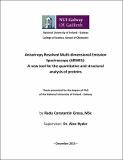| dc.description.abstract | The quantitative and structural analysis of proteins is of great importance in numerous fields (from industrial to academic research). Requirements like ease of analysis, sample handling, robustness, analysis time, the amount of analytical information provided and affordability may all be essential and must be taken into account when developing any analytical method. Fluorescence spectroscopy is a highly attractive method that can fulfill many of these requirements and has an ever-increasing number of applications aimed towards the study of proteins, based either on the use of intrinsic fluorescence or extrinsic labels.
One of the most important industrial sectors where new protein analysis techniques are in great demand is the BioPharma manufacturing industry. A typical bioprocess consists of growing cells or cell components (predominantly mammalian cells) in culture media (complex and often ill-defined mixtures) in order to produce recombinant therapeutic proteins. During these processes, proteins not only represent the final product (i.e. glycoproteins), but are also often used as additives (i.e. albumins, insulins) in some, if not most, culture media. Therefore, in many parts of the bioprocess it is vitally important to be able to measure both protein concentration and stability. This is especially challenging when the matrix (i.e. cell culture media or bioprocess broth) in which the protein is located is chemically complex.
The first part of this thesis research was based on developing new fluorescence based methods for the quantitative analysis of proteins in highly complex biogenic mixtures (which are themselves intrinsically fluorescent). Due to the complexity of such mixtures, the main issue was the unambiguous discrimination of protein emission from that of free amino acids present in the media. Anisotropy/polarization was the method of emission discrimination used and was integrated into multi-dimensional fluorescence (MDF) measurements (Chapter 3). This new method enabled the protein signal to be isolated based on the protein’s size compared to the free amino acids in media and enabled accurate protein concentration measurements (Chapter 4).
The MDF anisotropy spectra of albumin solutions showed a striped pattern that was a unique feature of multi-fluorophore proteins. We also noticed that these MDF anisotropy patterns changed differently depending on the specific unfolding pathway. The emission of albumins is complicated because of the multiple fluorophores present (Trp, Tyr, and to a lesser extent Phe). Combining anisotropy with MDF and chemometric data analysis allowed us to resolve emission from groups of Tyr and Trp and obtain a more in-depth understanding of the structural changes that occur compared to conventional fluorescence spectroscopy. Chemometric data analysis was used to extract the contributions of individual emitting fluorophores to the overall anisotropy pattern changes of human serum albumin during thermal and chemical unfolding. This new method was called Anisotropy Resolved Multi-dimensional Emission Spectroscopy (ARMES) and allowed for the tracking of specific protein domains during different unfolding/refolding processes (Chapter 5).
Chapter 6 focuses on the similarities and differences in photo-physics and unfolding/refolding behavior of human and bovine serum albumins. HSA and BSA, although are structurally very similar, they produced different MDF anisotropy patterns. The main differences in the photo-physics of the two albumins came from the extra Trp present in BSA. Although these differences are well known, the ARMES method represented a new way of comparing proteins based on their polarized emission and anisotropy patterns. ARMES analysis resolved the contribution of the second Trp residue in BSA and was used to track the slightly different unfolding pathway of BSA compared to HSA.
In the final part of the thesis (Chapter 7), the ARMES method was used to assess the more subtle protein structural changes that occur during processes such as: flash freezing/thawing (used for storing of protein products or to decouple the protein purification step in a bioprocess cycle), exposure to repeated thermal cycles and refolding upon cooling. In this chapter, the ARMES method, as it is currently implemented, was tested to its limits. ARMES showed that there were some small structural changes induced by different freezing methods, for example, but the errors associated with the chemometric data analysis were too high for a conclusive interpretation of results. | en_IE |


